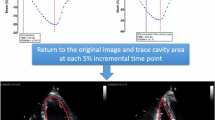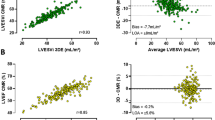Abstract
Two-dimensional (2D) speckle-tracking echocardiography (STE) has clarified functional adaptations accompanying the morphological features of ‘athlete’s heart’. However, 2D STE has some limitations, potentially overcome by three-dimensional (3D) STE. Unfortunately, discrepancies between 2D- and 3D STE have been described. We therefore sought to evaluate whether dimensional and functional differences exist between athletes and controls and whether 2D and 3D left ventricular (LV) strains differ in athletes. One hundred sixty-one individuals (91 athletes, 70 controls) were analysed. Athletes were members of professional sports teams. 2D and 3D echocardiography and STE were used to assess LV size and function. Bland–Altman analysis was used to estimate the level of agreement between 2D and 3D STE. Athletes had greater 2D and 3D-derived LV dimensions and LV mass (p < 0.0001 for all), while 2D- and 3D-derived LV ejection fraction did not differ as compared with controls (p = 0.82 and p = 0.89, respectively). Longitudinal, radial, and circumferential strains did not differ between athletes and controls, neither by 2D nor by 3D STE. Three-dimensional longitudinal and circumferential strain values were lower (p < 0.0001 for both) while 3D radial strain was greater, as compared with 2D STE (p < 0.001). Bland–Altman plots demonstrated the presence of an absolute systematic error between 2D and 3D STE to analyse LV myocardial deformation. 3D STE is a useful and feasible technique for the assessment of myocardial deformation with the potential to overcome the limitations of 2D imaging. However, discrepancies exist between 2D and 3D-derived strain suggesting that 2D and 3D STE are not interchangeable.


Similar content being viewed by others
References
Pluim BM, Zwinderman AH, van der Laarse A, van der Wall EE (2000) The athlete’s heart. A meta-analysis of cardiac structure and function. Circulation 101:336–344
Pelliccia A, Maron BJ, Spataro A, Proschan MA, Spirito P (1991) The upper limit of physiological cardiac hypertrophy in highly trained elite athletes. N Engl J Med 31:295–301
Caselli S, Di Paolo FM, Pisicchio C, Di Pietro R, Quattrini FM, Di Giacinto B et al (2011) Three-dimensional echocardiographic characterization of left ventricular remodeling in Olympic athletes. Am J Cardiol 108:41–47
Richand V, Lafitte S, Reant P, Serri K, Lafitte M, Brette S et al (2007) An ultrasound speckle tracking (two-dimensional strain) analysis of myocardial deformation in professional soccer players compared with healthy subjects and hypertrophic cardiomyopathy. Am J Cardiol 100:128–132
Caselli S, Montesanti D, Autore C, Di Paolo FM, Pisicchio C, Squeo MR et al (2015) Patterns of left ventricular longitudinal strain and strain rate in Olympic athletes. J Am Soc Echocardiogr 28:245–253
Nottin S, Doucende G, Schuster-Beck I, Dauzat M, Obert P (2008) Alteration in left ventricular normal and shear strains evaluated by 2D-strain echocardiography in the athlete’s heart. J Physiol 586:4721–4733
Butz T, van Buuren F, Mellwing KP, Langer C, Plehn G, Meissner A, Trappe HJ, Horstkotte D, Faber L (2011) Two-dimensional strain analysis of the global and regional myocardial function for the differentiation of pathologic and physiologic left ventricular hypertrophy: a study in athletes and in patients with hypertrophic cardiomyopathy. Int J Cardiovasc Imaging 27:91–100
Cappelli F, Toncelli L, Cappelli B, De Luca A, Stefani L, Maffuli N, Galati G (2010) Adaptative or maladaptative hypertrophy, different spatial distribution of myocardial contraction. Clin Physiol Funct Imaging 30:6–12
Galderisi M, Lomoriello VS, Santoro A, Esposito R, Olibet M, Raia R et al (2010) Differences of myocardial systolic deformation and correlates of diastolic function in competitive rowers and young hypertensives: a speckle-tracking echocardiography study. J Am Soc Echocardiogr 23:1190–1198
Simsek Z, Hakan Tas M, Degirmenci H, Gokhan Yazici A, Ipek E, Duman H, Gundogdu F, Karakelleoglu S, Senocak H (2013) Speckle tracking echocardiographic analysis of left ventricular systolic and diastolic function of young elite athletes with eccentric and concentric type of cardiac remodelling. Echocardiography 30:1202–1208
Soullier C, Obert P, Doucende G, Nottin S, Cade S, Pereze-Martin A, Messner-Pellenc P, Schuster I (2012) Exercise response in hypertrophic cardiomyopathy: blunted left ventricular deformational and twisting reserve with altered systolic–diastolic coupling. Circ Cardiovasc Imaging 5:324–332
Weiner RB, Hutter AM Jr, Wang F, Kim J, Weyman AE, Wood MJ et al (2010) The impact of endurance exercise training on left ventricular torsion. JACC Cardiovasc Imaging 3:1001–1009
D’Ascenzi F, Pelliccia A, Natali BM, Zacà V, Cameli M, Alvino F, Malandrino A, Palmitesta P, Zorzi A, Corrado D, Bonifazi M, Mondillo S (2014) Morphological and functional adaptation of left and right atria induced by training in highly trained female athletes. Circ Cardiovasc Imaging 7:222–229
Monte IP, Mangiafico S, Buccheri S, Bottari VE, Lavanco V, Arcidiacono AA, Lavanco V, Privitera F, Leggio S, Deste W, Tamburino C (2015) Myocardial deformational adaptations to different forms of training: a real-time three-dimensional speckle tracking echocardiographic study. Heart Vessels 30:386–395
Lang RM, Badano LP, Mor-Avi V, Afilalo J, Armstrong A, Ernande L et al (2015) Recommendations for chamber quantification by echocardiography in adults: an update from the American Society of Echocardiography and the European Association of Cardiovascular Imaging (2015). Eur Heart J Cardiovasc Imaging 16:233–270
De Castro S, Caselli S, Maron M, Pelliccia A, Cavarretta E, Maddukuri P et al (2007) Left ventricular remodelling index (LVRI) in various pathological conditions: a real-time three-dimensional echocardiographic study. Heart 93:205–209
Nagueh SF, Appleton CP, Gillebert TC, Marino PN, Oh JK, Smiseth OA et al (2009) Recommendations of evaluation of left ventricular diastolic function by echocardiography. Eur J Echocardiogr 10:165–193
Yu CM, Sanderson JE, Marwick TH, Oh JK (2007) Tissue Doppler imaging a new prognosticator for cardiovascular Disease. J Am Coll Cardiol 49:1903–1914
Ommen SR, Nishimura RA, Appleton CP, Miller FA, Oh JK, Redfiled MM et al (2000) Clinical utility of Doppler echocardiography and tissue Doppler imaging in the estimation of left ventricular filling pressures: a comparative simultaneous Doppler-catheterization study. Circulation 102:1788–1794
Oxborough D, Sharma S, Shave R, Whyte G, Birch K, Artis N et al (2012) The right ventricle of the endurance athletes: the relationship between morphology and function. J Am Soc Echocardiogr 25:263–271
Mor-Avi V, Lang RM, Badano LP, Belohlavek M, Cardim NM, Derumeaux G et al (2011) Current and evolving echocardiographic techniques for the quantitative evaluation of cardiac mechanics: ASE/EAE consensus statement on methodology and indications endorsed by the Japanese Society of Echocardiography. Eur J Echocardiogr 12:167–205
Burns AT, La Gerche A, Prior DL, Macisaac AI (2009) Left ventricular untwisting is an important determinant of early diastolic function. JACC Cardiovasc Imaging 2:709–716
Monaghan MJ (2006) Role of real time 3D echocardiography in evaluating the left ventricle. Heart 92:131–136
Seo Y, Ishizu T, Enomoto Y, Sugimori H, Aonuma K (2011) Endocardial surface area tracking for assessment of regional LV wall deformation with 3D speckle tracking imaging. JACC Cardiovasc Imaging 4:358–365
Vitarelli A, Capotosto L, Placanica G, Caranci F, Pergolini M, Zardo F, Martino F, De Chiara S, Vitarelli M (2013) Comprehensive assessment of biventricular function and aortic stiffness in athletes with different forms of training by three-dimensional echocardiography and strain imaging. Eur Heart J Cardiovasc Imaging 14:1010–1020
Maciver DH (2011) A new method for quantification of left ventricular systolic function using a corrected ejection fraction. Eur J Echocardiogr 12:228–234
Urbano-Moral JA, Rowin EJ, Maron MS, Crean A, Pandian NG (2014) Investigation of global and regional myocardial mechanics with 3-dimensional speckle tracking echocardiography and relations to hypertrophy and fibrosis in hypertrophic cardiomyopathy. Circ Cardiovasc Imaging 7:11–19
D’Ascenzi F, Pelliccia A, Alvino F, Solari M, Loffreno A, Cameli M, Focardi M, Bonifazi M, Mondillo S (2015) Effects of training on LV strain in competitive athletes. Heart 101(22):1834–1839. doi:10.1136/heartjnl-2015-308189
Kasikcioglu E, Oflaz H, Akhan H, Kayserilioglu A, Mercanoglu F, Umman B et al (2004) Left ventricular remodeling and aortic distensibility in elite power athletes. Heart Vessels 19:183–188
Galderisi M, Esposito R, Schiano-Lomoriello V, Santoro A, Ippolito R, Schiattarella P et al (2012) Correlates of global area strain in native hypertensive patients: a three-dimensional speckle-tracking echocardiography study. Eur Heart J Cardiovasc Imaging 13:730–738
Wu VCC, Takeuchi M, Otani K, Haruki N, Yoshitani H, Tamura M et al (2013) Effect of through-plane and twisting motion on left ventricular strain calculation: direct comparison between two-dimensional and three-dimensional speckle-tracking echocardiography. J Am Soc Echocardiogr 26:1274–1281
Reant P, Barbot L, Touche C, Dijos M, Arsac F, Pillois X et al (2012) Evaluation of global left ventricular systolic function using three-dimensional echocardiography speckle-tracking strain parameters. J Am Soc Echocardiogr 25:68–79
Saito K, Okura H, Watanabe N, Hayashida A, Obase K, Imai K et al (2009) Comprehensive evaluation of left ventricular strain using speckle tracking echocardiography in normal adults: comparison of three-dimensional and two-dimensional approaches. J Am Soc Echocardiogr 21:1025–1030
Xu TY, Sun JP, Lee AP, Yang XS, Qiao Z, Luo X et al (2014) Three-dimensional speckle strain echocardiography is more accurate and efficient than 2D strain in the evaluation of left ventricular function. Int J Cardiol 176:360–366
Maffessanti F, Nesser HJ, Weinert L, Steringer-Mascherbauer R, Niel J, Gorissen W et al (2009) Quantitative evaluation of regional left ventricular function using three-dimensional speckle tracking echocardiography in patients with and without heart disease. Am J Cardiol 104: 1755–1762
Hayat D, Kloeckner M, Nahum J, Ecochard-Dugelay E, Dubois-RANDé JL, Jean-François D et al (2012) Comparison of real-time three-dimensional speckle tracking to magnetic resonance imaging in patients with coronary heart disease. Am J Cardiol 109:180–186
Negishi K, Negishi T, Agler DA, Plana JC, Marwick TH (2012) Role of temporal resolution in selection of the appropriate strain technique for evaluation of subclinical myocardial dysfunction. Echocardiography 29:334–339
Acknowledgments
The authors wish to thank Pietro Piu for his support in the statistical analysis.
Author information
Authors and Affiliations
Corresponding author
Ethics declarations
Conflict of interest
None.
Rights and permissions
About this article
Cite this article
D’Ascenzi, F., Solari, M., Mazzolai, M. et al. Two-dimensional and three-dimensional left ventricular deformation analysis: a study in competitive athletes. Int J Cardiovasc Imaging 32, 1697–1705 (2016). https://doi.org/10.1007/s10554-016-0961-6
Received:
Accepted:
Published:
Issue Date:
DOI: https://doi.org/10.1007/s10554-016-0961-6




